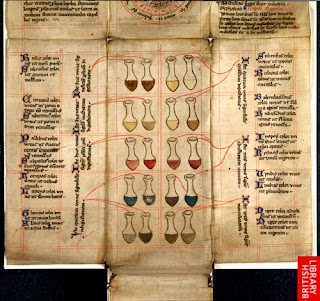If I asked you what came to mind when I say ‘medieval glass’
you might reply the stained glass at Chartres Cathedral, or perhaps the inner
casing of a holy reliquary, or maybe even an elaborate goblet set on a royal
dais; but it is quite unlikely that you’d think of a urinal.
 |
| Urinal, 1400s, Musuem of London |
Uroscopy was the diagnosis of a disease through the
examination of the colour of a patient’s urine. The urine flask became one of
the symbols of the physician’s trade, and a doctor can often by identified in
illuminated manuscripts by their possession of a glass flask.
 |
| Physician teaching students, Paris, 1300s, (British Library, Harley 3140, f. 32v). |
Physicians often owned charts that catalogued the different
colours of urine and the illnesses to which these could be linked. For example,
blue urine was associated with indigestion and black urine was meant to
indicate death.
 |
| Diagnostic chart, England, c.1406, (British Library, Harley 5311). |
It is important to remember the smaller, everyday objects and
not just the glamorous and glittering jewels of medieval life. But perhaps the
worlds of stained glass and urinals were not so distinct from each other. In
the Becket Miracle Windows at Canterbury Cathedral physicians were depicted
consulting their urine flasks, but the message was to rely not upon your
physician but rather on the healing power of the saint, even in those cases
when your urine was black.
 |
| Chartres Cathedral, Constantine has leprosy and consults a physician. |
Sicht Dir e Scholdenkonsolidéierungskredit, ongesécherte Krediter, Geschäftskrediter, Hypothekarkrediter, Autokrediter, Studenteprêten, perséinleche Krediter, Risikokapital, etc.! Ech sinn e private Kreditgeber, ech ginn Krediter u Firmen an Eenzelpersounen mat niddregen a vernünftege Zënssätz vun 2%. E-Mail un: christywalton355@gmail.com
ReplyDeleteZNAM DA ĆETE MI KASNIJE ZAHVALITI NA OVIM INFORMACIJAMA...
ReplyDeleteTOPLI POZDRAV LJUDIMA EUROPE, HRVATSKE, ZAGREBA, BOSNE, SRBIJE ITD. "" OVO JE IZVRSNA PRILIKA ZA VAS DA DOBIJETE KREDIT OD ALLIANT KREDITNE UNIJE. PRUŽAM VAM PLATFORMU ZA DOVLAČENJE KLIJENATA I PONUDIT ĆU IM KREDIT U DOBROJ VJERI. Imate priliku dobiti kredit u bilo kojoj denominaciji od 2000 (€, $, KUNA) - 5.000.000 (€, $, KUNA) s mogućnostima otplate od 1 godine do 45 godina bez previše obveza.
KONTAKT PODACI:
WhatsApp: +385-9156-08706
E-pošta: {hybridalliantcreditunion@gmail.com}